| A | B |
|---|
| A unit of genetic function common in bacteria and phages, consisting of coordinately regulated clusters of genes with related functions. | operon (below is a diagram of the lac operon and the molecules that regulate its transcription) p352,  |
| The regulator molecule that combines with the CAP protein to stimulate faster lac operon transcription is called _____. | cyclic AMP (cAMP. This molecule is also involved as a secondary messenger in many other signal transduction pathways. See p216) p355,  |
| A gene that codes for a protein, such as a repressor, that controls the transcription of another gene or groups of genes is called a(n) _____. | regulatory gene (lac1 is the regulatory gene for the lac operon. Notice that it isn't part of the operon) p353,  |
| A specific small molecule that inactivates the repressor protein in an operon. | inducer (allolactase, an isomer of lactose that occurs in small quantities when lactose is present, is the inducer in the lac operon system because it's presence ends up inducing the operon to be transcribed, making the instructions for making the enzyme that breaks down lactose; lactase, a.k.a B-galactosidase) p354,  |
| A protein that suppresses the transcription of a gene. | repressor (the repressor protein that stops the trp operon is the red molecule. It requires tryptophan as a corepressor to assume its active form) p353,  |
| A small molecule that cooperates with a repressor protein to switch an operon off. | corepressor (tryptophan is the corepressor in the trp operon) p353,  |
| In prokaryotic DNA, a sequence of nucleotides near the start of an operon to which an active repressor can attach, preventing the attachment of RNA polymerase to the promoter (which prevents transcription). | operator (the yellow part of the operon below) p352,  |
| A protein that binds to DNA and stimulates transcription of a specific gene. | activator p355 |
| What are two general strategies for regulating metabolic pathways? | 1) Regulate the enzymes themselves. 2) Regulate the transcription of the enzymes. p352,  |
| A promoter, an operator, and the genes they control make up a(n) _______. | operon p352,  |
| The lac operon is a(n) _______ operon because it is usually off but can be switched on. | inducible operon p353,  |
| The trp operon is a(n) _____ operon because it is usually on but can be switched off. | repressible operon p353,  |
| Regulation of both the lac operon and the trp operon involve the ______ regulation of genes because the operons are switched off by the active forms of the repressor protein. | negative p355,  |
| The attachment of CAP to the promoter of the lac operon is an example of _______ regulation because it directly stimulates gene expression. | positive regulation p355,  |
| In both prokaryotes and eukaryotes, gene expression is most often regulated at the stage of _______. | transcription p351,  |
| DNA wraps around ________ to form chromatin. | histone proteins p320, 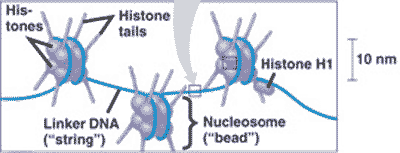 |
| During development of multicellular organisms, cells undergo a process of becoming specialized in form and function in a process called ________. | cell differentiation (this involves activating certain genes and permanently silencing others, such as genes for liver proteins in a pancreas cell) p367 |
| Differences between cell types are due NOT to different genes being present in the cell but to ______. | differential gene expression p356 |
| What affect does the acetylation of histone tails have on the ability of DNA to be transcribed? | makes it easier (because the acetyl group -COCH3 neutralizes the positive charge of the histone protein, loosening the grip of the histone on the negatively charged DNA. It also loosens their attraction to neighboring nucleosomes) p357, 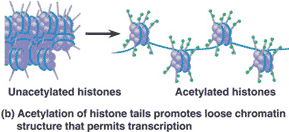 |
| What affect does the methylation of histone tails have on the ability of DNA to be transcribed? | makes it harder p357 |
| DNA that is ______ is generally inactive. | methylated p358 |
| Once methylated, genes usually ______ through successive cell divisions. | stay that way (this can permanently silence genes that arise from the methylated parent cell) p358 |
| Genomic imprinting, where genes are expressed depending on the sex of the parent, is caused by ______ of maternal or paternal alleles early in the development process, affectively shutting the alleles down even in daughter cells that are formed from then on. | methylation p358 |
| Inheritance of traits transmitted by mechanisms not directly involving the nucleotide sequence is called ____ inheritance. Methylation, which can silence genes even in successive cell divisions, is an example. | epigenetic inheritance p358 |
| The cluster of proteins that assembles on the promoter sequence at the upstream end of a gene is called the _____. | transcription initiation complex p358,  |
| Segments of non-coding DNA that help regulate transcription by binding certain proteins are called ______. | control elements p358,  |
| To initiate transcription, eukaryotic RNA polymerase requires the assistance of proteins called ______. | transcription factors p358,  |
| Transcription factors that are essential for the transcription of ALL protein-coding genes are called ______ transcription factors. In order to get high levels of transcription of a particular gene, additional _________ transcription factors are required. | general, specific (the activators in this diagram are a type of specific transcription factor) pp358&359,  |
| Groupings of distal control elements collectively are also called _____. | enhancers p359,  |
| Enhancers are made up of multiple _______. | distal control elements p359,  |
| Enhancers (a.k.a. distal control elements) interact with two types of specific transcription factors, ______ and ______. | activators and repressors p359,  |
| In eukaryotes, the precise control of transcription depends largely on the binding of proteins called _______ to DNA segments called control elements. | activators pp360&361,  |
| Name four mechanisms of post-transcriptional regulation of gene expression. | 1) RNA processing 2) mRNA degradation 3) Initiation of translation 4) Protein processing and degradation pp362&363 |
| One example of regulation at the RNA processing level is _______, in which different mRNA molecules are produced from the same primary transcript, depending on which RNA segments are used as exons and which are used as introns. | alternative RNA splicing p363,  |
| What most often affects the length of time that mRNA survives in the cytoplasm? | nucleotide sequences in the 3' UTR p363 |
| What are two effects that microRNA's (miRNA) can have on mRNA? | 1) It can bind to mRNA, blocking its translation 2) It can bind to mRNA and degrades it (both process require the binding of a protein to the miRNA's,  |
| The initiation of translation of selected mRNA's can be blocked by regulatory proteins that bind to specific sequences or structures within the _______ of mRNA. | 5' UTR, 3' UTR (untranslated region) p363, 334, and 340,  |
| To mark a particular protein for destruction, the cell commonly attaches molecules of a small protein called ______ to the protein. Giant protein complexes called ______ then recognize the tagged protein and degrade it. | ubiquitin, proteasomes p363,  |
| In eukaryotes, the rate of gene expression can be strongly increased or decreased by the binding of ______ transcription factors, either _____ or _____, to the control elements of enhancers. | Specific transcription factors, activators or repressors p358&359,  |
| The genes that normally regulate cell growth and division include genes for ______, their _______, and ________ molecules. Mutations that alter any of these genes in somatic cells can lead to _____. | growth factors, their receptors, signaling pathway molecules, cancer p373 |
| The Epstein-Barr virus, Human papillomavirus (HPV) and HTLV-1 virus have all been identified as ____ viruses that cause ______. | tumor viruses, cancer p377 |
| Cancer causing genes are called _____. | oncogenes (the normal version of these cellular genes are called proto-oncogenes. They are usually involved with normal stimulation of cell growth and division. These genes are ones that commonly mutate to form oncogenes) p373 |
| ______ code for proteins that stimulate normal cell growth and division, but can be turned into a cancer-causing gene by mutations. | proto-oncogenes p373 |
| The first sign of cancer may be a small benign growth called a(n) ______. | polyp p376, 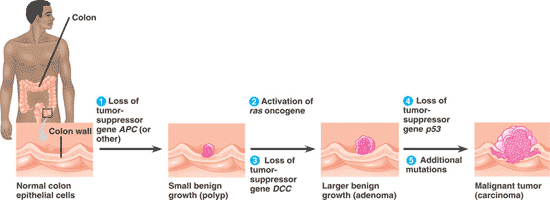 |
| A benign tumor larger than a polyp, but still benign is called a(n) _____. | adenoma p376,  |
| A tumor large enough to impair function of one or several organs is called a _____ or ______. | carcinoma, malignant tumor p376,  |
| An individual ______ an oncogene or mutant allele of a tumor-suppressor gene is one step closer to accumulating the necessary mutations for cancer to develop by the _____ model of cancer development. | inheriting, multistep p376,  |
What is "A" pointing to in the picture below?, 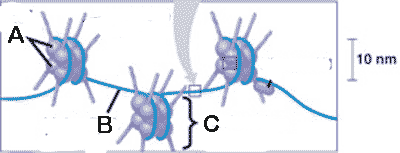 | histone proteins p357,  |
| The more open, unraveled form of eukaryotic chromatin that is available for transcription. | euchromatin G13 and p322 |
| A gene found in viri or as a mutated form of normal gene that is normally involved with regulating the cell cycle, but now is involved in triggering cancerous characteristics. | oncogene p373 |
| A giant protein complex that recognizes and destroys proteins tagged for elimination by the small protein ubiquitin. | A proteasome p363,  |
| The guardian angel of the genome, this gene is expressed when a cell's DNA is damaged. Its product is a transcription factor that transcribes proteins whose job it is to keep mutated cells from dividing or help repair damaged DNA. | p53 gene p376, 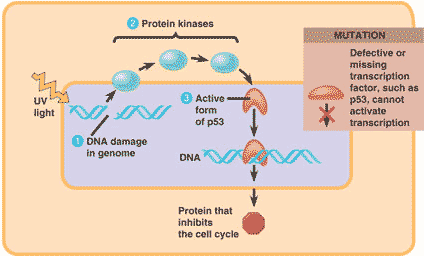 |
| A gene that codes for a type of G protein that relays a growth signal from a growth factor receptor on the plasma membrane to a cascade of protein kinases that ultimately results in the stimulation of the cell cycle. Point mutations in this gene can lead to a hyperactive version of the protein that can lead to excessive cell division and cancer. | Ras gene pp374&375,  |
| A segment of noncoding DNA that helps regulate transcription of a gene by binding proteins called transcription factors. | control element p358,  |
| Expression of different sets of genes by cells with the same genome is called _____. | differential gene expression p356 |
| Nontranscribed eukaryotic chromatin that is so highly compacted that it is visible with a light microscope during interphase. | heterochromatin p357 |
| A protein that suppresses the transcription of a gene is called a(n) _____. | repressor p353 |
| A normal cellular gene corresponding to an oncogene; a gene with the potential to cause cancer, but that requires some alteration to become an oncogene. | proto-oncogene p373 |
| The phenomenon in which expression of an allele in offspring depends on whether the allele is inherited from the male or the female parent. | genomic imprinting (Depending on which parent a particular allele comes from, the allele may be silenced, usually by methylation during gamete formation. For instance, a certain allele for a given species might always be silenced if it is found in sperm, but not in eggs. The silenced allele will be passed on to the zygote, and subsequently, all cells in the offspring. But if the offspring is female, the allele will be unsilenced when she makes her eggs. In this case, females will never pass on the silenced allele, but females can inherit the silenced allele if her father passes on this allele. p358, G-15, figure 15-17 |
| A technique to silence the expression of selected genes in non-mammalian organisms. The method uses synthetic double-stranded RNA molecules that match the sequence of a particular gene to trigger the breakdown of the gene's messenger RNA. | RNA interference (Also called RNAi, this technique was found to be similar to natural processes that cells use to regulate translation using molecules called miRNAs "microRNAs" and siRNAs "small interfering RNA's." These types of double stranded RNAs become single stranded and associate with a protein to form a complex that recognizes, binds to, and either blocks or destroys mRNA in the cytoplasm) p365, .jpg) |
| A gene whose protein products inhibit cell division, thereby preventing uncontrolled cell growth (cancer). | tumor-suppressor gene p374 |
| Inducible enzymes usually function in ______ pathways of metabolism. | catabolic (By producing the appropriate amount of enzymes only when a nutrient is available to be broken down, the cell avoids wasting energy and precursors making proteins that are not needed) p355 |
| Repressible enzymes usually function in ______ pathways of metabolism. | anabolic (By suspending production of an end product when it is already present in sufficient quantity, the cell can allocate it organic precursors and energy for other uses) p354 |
| What does "ncRNA" stand for? | non-coding RNA's (a.k.a. - non-protein coding RNA's. New ncRNA's are being discovered, including miRNA's, siRNA's, and piRNA's. These are small ncRNA's that play a role in regulating gene expression) pp364-366 |
| Activator and repressors are types of ________ that bind to _______ elements of ______. | specific transcription factors, control elements, enhancers pp358&359,  |
| In the multistep model of cancer development, about a half a dozen changes must occur at the DNA level for a cell to become fully cancerous. These changes usually involve the appearance of at least one oncogene and the mutation or loss of several _____ genes. | tumor-suppressor genes p376 |
| HPV, the human papillomavirus, is a virus that is often sexually transmitted and is associated with _____ in females and ____ in males. | cervical cancer, genital warts (This is a type of virus with many different forms. It is usually transmitted sexually and can lie dormant without producing symptoms for years. Yet it can still be transmitted while asymptomatic. The strains that cause genital warts (in men and women) are not the same ones that increase the risk of cervical cancer. It is estimated that around 3/4ths of older adults carry this virus. Young adults are now able to get vaccinated against the most common and dangerous forms of the virus) p377 |
| The physical processes that give an organism its shape constitute _________. | morphogenesis p367 |
| The end of an animal that is near the head is called the _______ end. | anterior p370 |
| The end of an animal that is near the tail is called the _______ end. | posterior p370 |
| The belly of an animal is said to be on the ______ side of the body. | ventral p370 |
| The back of an animal is said to be on the ______ side of the body. | dorsal (Think about the dorsal fin of a shark sticking out of the water) p370 |
| Maternal substances in the egg that influence the course of early development are called ___________. | cytoplasmic determinants p367 |
| What are the two sources of information that tell a cell which genes to express at any given time during embryonic development? | 1) Cytoplasmic determinants in the egg. 2) Induction by nearby cells p367,  |
| Even before fertilization in Drosophila, neighboring nurse cells cause localization of _______ mRNA at one end of the egg, thus helping to establish the anterior end of the future embryo. | bicoid mRNA p372, 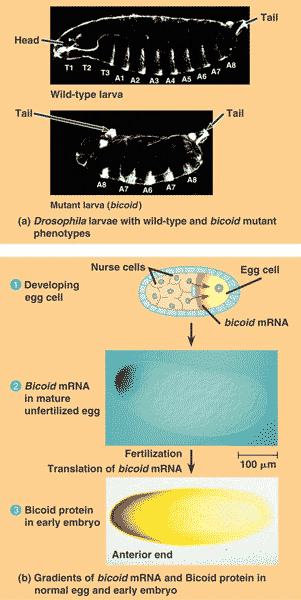 |
| In the process of ______, a target cell is stimulated to differentiate its gene expression through signals from adjacent or nearby cells during embryonic development. These signals from nearby cells may be in the form of cell-surface molecules on adjacent cells and/or the binding of growth factors secreted by nearby cells. | induction p367 |
| In Drosophila, _________ is an example of a cytoplasmic determinant. | bicoid mRNA (The term "morphogen" can also apply because the bicoid mRNA forms a gradient that helps establish the developmental axes. The term "Bicoid" by itself refers to the protein product of bicoid m-RNA that gets translated once the egg is fertilized. Bicoid is also a morphogen, but is not a cytoplasmic determinant, because it did not enter the egg from the mother's cells) p372,  |
| In Drosophila, bicoid mRNA is an example of a __________. | cytoplasmic determinant (The term "morphogen" can also apply because the bicoid mRNA forms a gradient that helps establish the developmental axes. The term "Bicoid" by itself refers to the protein product of bicoid m-RNA that gets translated once the egg is fertilized. Bicoid is also a morphogen, but is not a cytoplasmic determinant, because it did not enter the egg from the mother's cells),  |
| During development, certain cells are meant to die instead of divide. This programmed cell death is called ______. | apoptosis p376 |
| The ordering of cells into specific three-dimensional structures, critical for shaping an organism and its individual parts during development, is called _____. | pattern formation p369 |
| Another name for a maternal effect gene (a gene that helps control the orientation of the egg). | egg-polarity gene p372 |
| A gene that, when mutant in the mother, results in a mutant phenotype in the offspring, regardless of the offspring's genotype. | maternal effect gene (Also called egg-polarity genes, the normal version of these genes produce cytoplasmic determinants that enter the egg and help the fertilized zygote differentiate in subsequent divisions to establish the anterior-posterior and dorsal-ventral axes of the developing embryo) p371 |
| The progressive restriction of developmental potential, causing the possible fate of each cell to become more limited as the embryo develops. | determination p368 |
| A mutation with a phenotype leading to death at the embryo or larval stage is called a(n) ______. | embryonic lethal p371 |
| Any of the master regulatory genes that control placement and spatial organization of body parts in animals, plants, and fungi by controlling the developmental fate of groups of cells is called a(n) ______. | homeotic gene p371 ,G-17 |
| The molecular cues that control pattern formation, collectively called ________, are provided by cytoplasmic determinants and inductive signals. | positional information p370 |
| A substance, such as Bicoid protein, that provides positional information in the form of a concentration gradient along an embryonic axis. | morphogen p372 |
| In the process of induction, a target cell is stimulated to differentiate its gene expression through signals from adjacent or nearby cells during embryonic development. These signals from nearby cells may be in the form of ______ molecules on adjacent cells and/or the binding of _______ secreted by nearby cells. | cell surface molecules, growth factors p367 |
| Once an embryonic cell has undergone ______, it is irreversibly committed to its normal fate. | determination p368 |
| What do you call the proteins that are made in a differentiated cell type, but not in other cell types due to differential gene expression? | tissue-specific proteins p368 |
| The molecular cues that control pattern formation, collectively called positional information, include ______ and ________. | cytoplasmic determinants, inductive signals p370 |
| The products of _____ genes are cytoplasmic determinants. These include proteins and/or RNA that are produced by the mother and enter the egg but don't spread out evenly in the egg. The different concentration of these substances in the egg lead to the establishment of the axes in the developing embryo. | maternal effect genes (a.k.a. - egg polarity genes) p371 |
| The products of maternal effect genes are ______. These include proteins and/or RNA that are produced by the mother and enter the egg but don't spread out evenly in the egg. The different concentration of these substances in the egg lead to the establishment of the axes in the developing embryo. | cytoplasmic determinants p371 |
| The products of maternal effect genes are cytoplasmic determinants. These include ____ and/or ____ that are produced by the mother and enter the egg but don't spread out evenly in the egg. The different concentration of these substances in the egg lead to the establishment of the axes in the developing embryo. | proteins, RNA p371 |